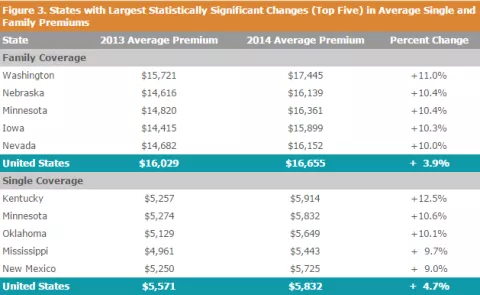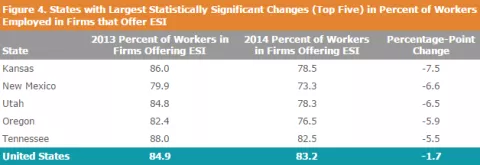Employer Health Insurance Mostly Stable in First Year Post-ACA, but Some States Show Increased Take-up, Decreased Offer
The Agency for Healthcare Research and Quality (AHRQ) recently released its first state estimates of post-ACA employer-sponsored health insurance (ESI) from the Medical Expenditure Panel Survey-Insurance Component (MEPS-IC). In this blog, we examine 2014 state estimates of ESI offer, eligibility and take-up, showing changes since 2013 that are statistically significant at the 95 percent confidence level.
While national data show statistically significant changes in worker offer, eligibility, take-up and total average premiums between 2013 and 2014, there were not significant changes in most states. However, those states that did see statistically significant changes largely mirrored the national trends. The following are highlights from the new data.
Ten states saw increases in workers opting to enroll in health insurance (Figure 1).
Consistent with the national trend, 10 states experienced significant increases in the percentage of workers choosing to enroll in health insurance (known as coverage “take-up”) when their employers offered it to them, while only Maine experienced a significant decline in take-up. The national-level increase in take-up is a change from the decline in take-up that had occurred for more than a decade.
Note: Estimates represent enrollment in health insurance by workers eligible for coverage, if their employers offer employer coverage.
Four states experienced decreases in the percent of workers eligible for employer-based coverage (Figure 2).
Four states experienced significant declines in the percentage of workers eligible for health insurance in businesses that offer coverage, while none saw significant increases. The decline in these four states is consistent with a national decline in eligibility from 2013 to 2014. The national-level decline is a change from the previous two years, during which national levels were statistically stable.
Note: Estimates represent eligibility for health insurance, if their employers offer coverage.
Nine states saw premium increases for single coverage, and 11 saw increases in family coverage (Figure 3).
Nationally, average annual premiums increased significantly for both single and family coverage, a trend also found in several states. Average annual premiums for single coverage increased significantly in nine states, ranging from 6.5 percent in Texas to 12.5 percent in Kentucky. Premiums for family coverage also increased significantly in 11 states, ranging from 5.7 percent in Texas to 11.0 percent in Washington. Nationally, premiums increased 4.7 percent for single coverage and 3.9 percent for family coverage.
Seven states experienced decreases in the percent of workers employed in businesses that offered coverage (Figure 4).
The percentage of workers in businesses that offered coverage decreased significantly between 2013 and 2014 in seven states, and it increased in one state (Colorado) from 80.9% to 84.7%. This is consistent with national trend, in which the percentage of workers employed in firms offering coverage has declined for the past several years, including from 2013 to 2014.
Further Reading: AHRQ Chartbook with Longer-Term ESI Trends since 2003
In addition to releasing 2014 MEPS-IC state estimates, AHRQ also has published a chartbook that looks at longer-term trends in ESI since 2003, including offer, eligibility and take-up; premiums, with employer and employee contributions; and cost sharing. The chartbook is available here.




